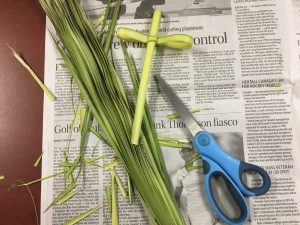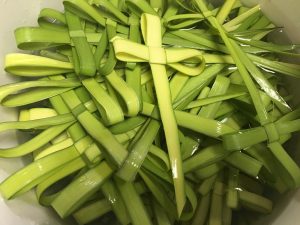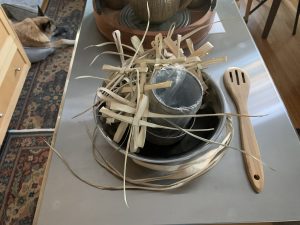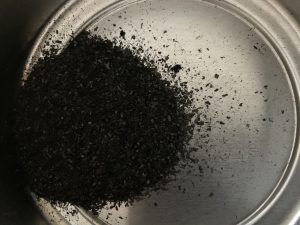About a year ago I was having some painting done in my house and I had the following conversation with my painter:
“So, I’m just going to run out to the back yard for a little while, if you see smoke and fire, don’t worry about it.”
“Um, OK.”
“You see, tomorrow is Ash Wednesday and I need to burn these palms in order to make ashes so that tomorrow I can smear them on people’s foreheads, look them in the eye, and remind them they are going to die.”
Short pause.
“Your job is really weird. Good. But weird.”
My job is weird. Good. But weird.
There are all sorts of traditions and practices connected to Lent and Holy Week in the Anglican Church but today I thought I’d walk you through the life cycle of a palm.
First, there is an entire part of this story that I don’t really know anything about. For those of us who live in parts of the world where we can’t easily grow palms we rely on someone else to grow them and ship them to us. We buy ours from a local church supply shop, but a friend of mine in North Carolina told me that her church just heads out into the brush behind the church and cuts down as many as they need.
On the Saturday before Palm Sunday, members from the two church congregations that share the building gather together to fold palms. (saint benedict’s table rents space in All Saints’ Anglican Church. We are two separate congregations but we look to work together whenever it makes sense to do so.)
At this point the palms are green and wet and relatively easy to fold. Every year I need to re-learn the process but gradually muscle memory kicks in and I can fold the palms without really thinking too much about it.
At our church we fold the palms into simple crosses, but a google search will show you palms transformed into amazing works of art.


But why do we fold palms in the first place?
One way to answer the question is to point out that when Jesus entered Jerusalem people waved palm branches and we remember this event in his life on Palm Sunday. (Click here to read last year’s Palm Sunday sermon for more details.)
But for me, folding palms goes deeper than a simple commemoration of an event. You can easily have a Palm Sunday service without spending time and money folding palms.
I have spent my whole life in churches and, while I never heard anyone say this using these exact words, the churches I was raised in believed it was much more important to ensure I had Jesus in my head than my heart.
Being a Christian meant I needed to learn a series of ideas and agree that I believed they were true. It was all about my head.
And those ideas were reflective of a particular way of understanding who Jesus was – a Jesus who was seen through the lens of white, colonial, heteronormative patriarchy.
I’m only just now beginning to come to see just how damaging that was.
One of the ways that this “inviting Jesus into my head” form of Christianity has been damaging is it ignores the diverse experiences of the people God created. God created people who are nonverbal, people who will never be able to read or process complex Statements of Faith, people whose first language and ways of connection is through dance and their bodies or the visual arts and surely God wants to be in relationship with these people too.
Which means that there have to be more ways to connect with God than the methods that the churches I grew up in privileged.
So now I try to find as many ways as possible to help people connect. Touching, smelling, and folding palms connects us to God. Holding them in our hands during the Palm Sunday service as we move our bodies, sing, speak, and listen amplifies that connection.
After the service people will take those crosses home and tuck them in a prayer book, or the corner of a picture frame or a window sill. They will quickly shrivel and dry as we move through the early days of Holy Week but they’ll remain in those spots through the year until we are all reminded a week or two before Ash Wednesday to return them to church to be burned.
The year I was shown how to turn palms into ashes I was overtaken by geeky joy, but this year I almost missed the beauty of the moment in my busyness. I was about to just try and quickly burn the palms before rushing off to the next thing on my to do list when I was overtaken with the difference a few short years could make on my attitude.
So I stopped, collected myself and entered prayerfully into the process. I collected all my supplies – dried palms, several metal bowls, a lighter, a spoon, and a sieve. This year I also experimented with cutting the palms into smaller pieces before I began. When the flame hits long curly palm branches the fire can become unruly and hard to control.

I went outside and placed the bowl with the palm pieces in the snow on top of my raised vegetable garden. My garden is in its own Lenten season – dormant and dead, but in a few short months it too will be filled with new life.
As I watched the smoke billow out of the bowl I thought of all the people who had folded, saved, and returned those palms. I thought of the people who would come to our Ash Wednesday liturgies and a feeling of gratitude enveloped me that was thicker than the smoke.

Once burned, the palms need to be pressed through a sieve to break up any larger pieces and make them suitable for marking people’s foreheads with a tangible sign of their mortality.
“Remember you are dust and to dust you shall return.”

The first ashes, however, were dispersed earlier then they should be. It happens every year but I always forget to watch for an unexpected gust of wind that will appear out of nowhere as I pass the ashes through the sieve, disbursing them throughout my neighborhood.
Which is as it should be.
Thanks for sharing!!!
My pleasure!
That’s a grand reflection on a good, weird practice!
Thanks!